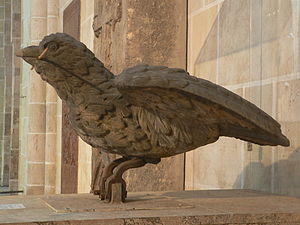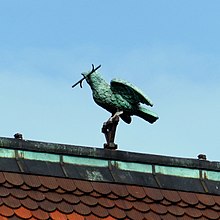The topic of this article may not meet Wikipedia's general notability guideline. (September 2014) |
This article needs additional citations for verification. (September 2014) |
The Ulm Sparrow (Ger. Ulmer Spatz) is a landmark in, and symbol of, the German city of Ulm.[1] The landmark is a statue of a bird that sits atop the Ulm Minster, the tallest church in the world.[2]


Legend edit
According to legend, the inhabitants of Ulm needed a particularly large beam for the construction of Ulm Minster, but could not get it through the city gate. As they were about to tear the gate down, they noticed a sparrow carrying a straw for its nest; which turned it from crosswise to lengthwise in its beak. A realization descended on the people of Ulm. Since that epiphany, they have placed long loads along rather than across their carts and were able to enter the city without rebuilding their gate.[3]
The legend is first recorded in an 1842 poem by Carl Hertzog.[4]
The figure on the nave of Ulm Minster was donated by wealthy citizens. It is not a sparrow, but a dove carrying an olive branch in its beak, as in the biblical story of Noah's Ark. It is small in relation to the building, and only easily visible from the tower. Due to its perceived size, the inhabitants came to refer to it mockingly as a sparrow, and the legend grew from there.[citation needed]
Cultural references edit
- Ulmer Spatz is a nickname both for inhabitants of Ulm and for players in the sports club SSV Ulm 1846.
- Ulmer Spatz is a glazed bread roll, similar to a pretzel.[5]
- A children's and youth's choir is named Die Ulmer Spatzen.
- A tramcar called Ulmer Spatz operates at weekends from Ulm through the Swabian Jura.
- A restored cruise ship on the Upper Danube is named Ulmer Spatz.
- Asteroid 8345 Ulmerspatz is named after the Ulm Sparrow.[6]
References edit
- ^ "The Sparrow of Ulm - Abiyoyo". www.abiyoyo.com. Retrieved 2015-11-18.
- ^ Shuffelton, Frank, ed. (1993). A Mixed Race: Ethnicity in Early America. Oxford University Press. p. 130. ISBN 9780195075236.
- ^ Fodor's See It Germany. Fodor’s Travel Publications. 2012. p. 329.
- ^ "Die Geschichte vom Ulmer Spatz". Baden-Württemberg.de. Retrieved 24 November 2014.
- ^ Lennert, Joachim (2003). Culinary Guidebook: Germany. Hueber. p. 60. ISBN 9783190063826.
- ^ Schmadel, Lutz D. (2012-06-12). Dictionary of Minor Planet Names. Springer Berlin Heidelberg. p. 633. ISBN 9783642297182.
Gallery edit
-
at the music school
-
on a fashion shop
-
at a jewelry store
-
at the restaurant Ulmer Spatz
-
The sparrow on the roof (in the centre of the picture)